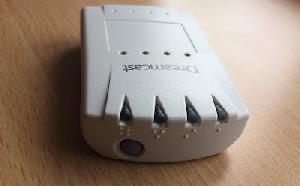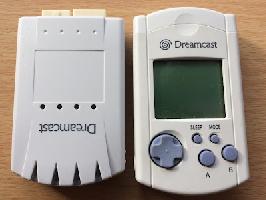
There are tonnes of third party memory cards for the Dreamcast, almost all of which don't feature the same monochrome LCD display and internal wizardry of the official VMU. There are also a plethora of third party cards that offer an advantage over the official memory unit in that they contain more storage space, and multiple 'pages' that can be switched between using a little button. I have several of these made by Joytech and while they look a bit garish with their blue/green plastic shells, they do the job just fine. Offering four times the capacity of a regular VMU but omitting a screen and face buttons, they are cheap and cheerful alternatives.

What you may not know, is that Sega actually released their own official multi-page non-visual VMU in late 2000, imaginatively titled the Dreamcast Memory Card 4X. This multi card was only released in Japan and the US (in the US, it was called the 4x Memory Card), and never made its way to Europe, like so many other cool devices for the Dreamcast. Anyway, I recently saw one of these Memory Card 4X things on eBay for the bargain price of £20, and having never seen one in the flesh (plastic) I snapped it up. A few days later it found its way through my letterbox in a scrunched up brown envelope and here for your delectation are my thoughts and closer inspection of the thing.

Now, before I continue I realise that this is hardly a new thing to be talking about. Well, it's new to me...but what I mean is that this device has been covered previously by
Adam Koralik on his YouTube channel
and there are entries about it on both
Sega Retro
and
Wikipedia
. What I'm doing here is giving my own thoughts and opinions on an item I hadn't previously held in my own two hands. Now, the first thing that surprised me when I furiously ripped open the envelope that Royal Mail had somehow managed to screw into a perfect sphere before stuffing through my letterbox, was that the Dreamcast Memory Card 4X was contained inside a rather lovely luminous orange pouch:

This translucent polythene pouch with Dreamcast logo is actually a VMU holder (complete with belt strap on the rear) that was available to Japanese Dreamcast owners through the Dream Point Bank. We've discussed the Dream Point Bank here several times (look
here
,
here
and
here
for other Dream Point Bank guff), and this VMU pouch appears to have been a fairly low-end prize. Nonetheless, it's a nice item to have and not one I was expecting as it wasn't even mentioned in the eBay listing. Quite why you'd want to attach a VMU holder to your belt is open to debate, but the late 1990s were a weird time. Probably even weirder in Japan. Probably. Weirder than they were for me stuck in shitty Manchester, anyway. Maybe.
Definitely Maybe
. Cough. Lets move on to the hardware.
The memory card itself shares similar dimensions with the standard VMU, but there is no screen and there are no face buttons. Instead, it features a row of LEDs and some lenses on the top that further indicate which of the four built-in memory cards you are using.
This is a nice touch absent from a lot of other 4x memory cards and makes the thing extra useful if you have it stuck in slot two of the controller with a standard VMU in slot one, as you can then see which card is activated. Speaking of activating the various 'pages,' this is done via a little grey button embedded in the top of the unit. As with the other memory cards of this ilk, you can press this little button while on the memory card screen of the Dreamcast's dashboard and it'll cycle between them as if you were simply removing VMUs.


There are a couple of other nice touches too. For instance, the LEDs are orange so they match the NTSC aesthetic of the swirl and console light (I just assumed they'd be red, like on other multi cards), and on the top there are a little visual indicators as to which card you're accessing in the form of (almost braille-like) notches. Hardly award-winning industrial design choices, but nice touches nonetheless. Now, onto the slightly odd aspects of this little contraption.
First, it doesn't have a lid for the business end and as far as I can ascertain, it never did. Even brand new in box Dreamcast Memory Card 4Xs did not ship with a little plastic end capsule to protect the connectors. Even stranger, the ones from a standard VMU will not fit due to an extra bit of plastic moulded to the connector, and the fact that the top of the card is a different shape.


Further to this, the Dreamcast Memory Card 4X will not fit onto a VMU for the exact same reason. I'm pretty sure even being able to do this would be redundant due to the lack of a screen or buttons, but it does seem a little odd that Sega expressly wanted to prevent users from being able to pair the two devices together in an eternal waltz of antiquated technology. Which is something I'm always keen to do. Perhaps the strangest thing about the Dreamcast Memory Card 4X though, is that it isn't 100% compatible with all games. Indeed, there is a list of games that will not recognise it for whatever reason, and via the power of the Wayback Machine, I have reproduced one from a long-gone
Gamespot article
here:
Hite E: White Illumination
Dynamite Cop 2
Air Force Delta
Maboroshi Oboro
Kitaihei Gold
F1 World Grand Prix
Carrier
Nanatsu No Hikan
Sekai Fushigi Hakken: Trojan
Bikkuriman 2000
Rayman 2
Sakura Momoko Gekijyo: Coji-Coji
Spawn: In The Demon's Hand (thanks CD ageS)
Sega Rally Championship 2
Marionette Company
Shenmue Chapter 1
Death Crimson 2
Zombie Revenge
Maken X
Hello Kitty's Lovely Fruits Pack
Hello Kitty's Garden Panic
Hello Kitty's Magical Block
D2
Toy Ranger
Undercover 2025 AD Kei
Get Colonies
Memories Off: Complete
Frame Gride
You'll notice that the list is split into two. The top half of the list contains games that just flat out refuse to recognise the Dreamcast Memory Card 4X, while the bottom half apparently does but only if you choose your card/page before booting the system. I tried Sega Rally 2 and the game tried to access the card (indicated by a flickering of the LED on the card), but it wouldn't recognise it at all. Quite why these games either do not recognise an official Sega memory device or only do so with some tinkering is not clear to me, but if anyone else out there knows the reasons, please be sure to leave a comment. No snark, please.



Finally the Dreamcast Memory Card 4X has its own HKT number - HKT4100 - and the rear of the unit also carries a
Conformité Européene or 'CE' marking
, indicating that a European release was fully intended before the plug was pulled on the Dreamcast. Another sad reminder of what could have been. Anyway, the Dreamcast Memory Card 4X is a worthy addition to any collection, even with the odd incompatibility with certain games.